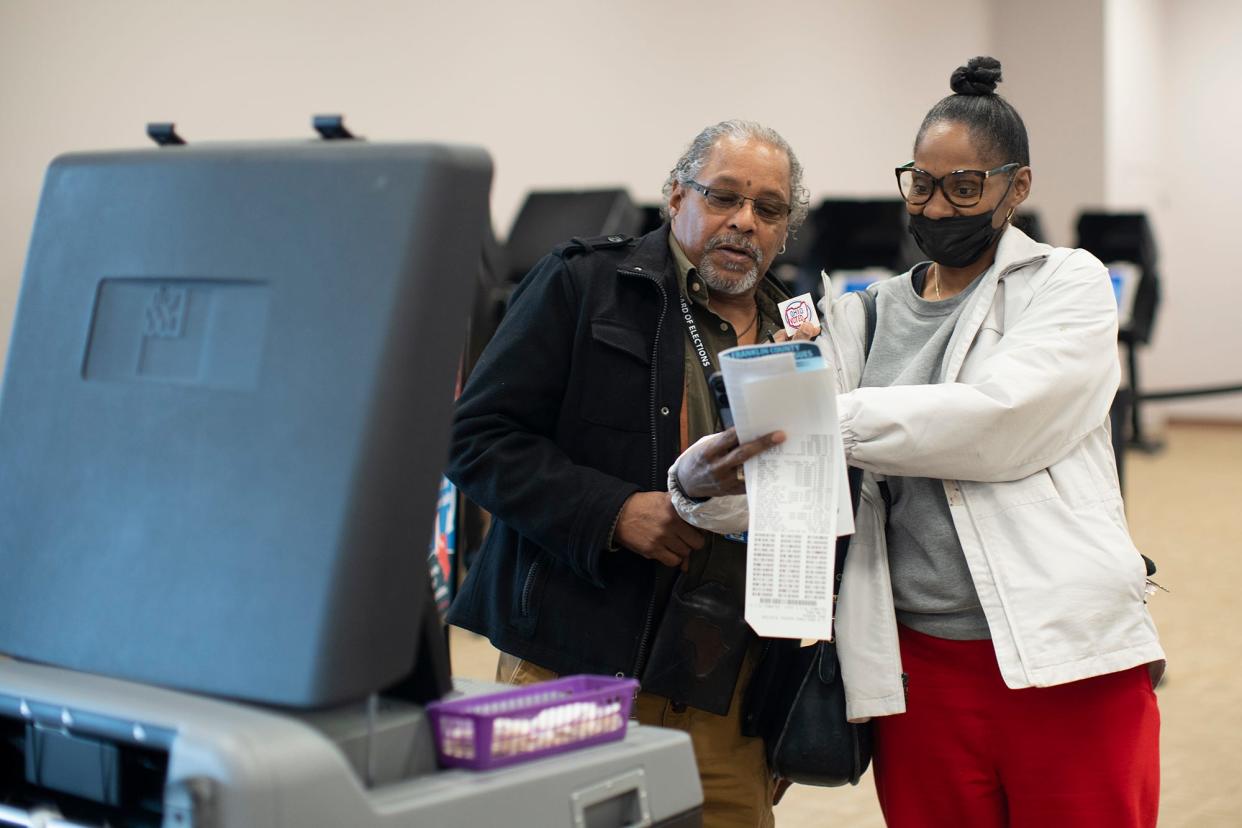Ohio Politics Explained: What's on your November ballot?

- Oops!Something went wrong.Please try again later.
- Oops!Something went wrong.Please try again later.
- Oops!Something went wrong.Please try again later.
The midterm elections are right around the corner, and Ohio voters are going to decide who they want in Congress, the governor's mansion, the Ohio Supreme Court and whether noncitizens should be allowed to vote in local elections.
It's a big ballot, and we break down all of it on this week's episode of Ohio Politics Explained.
A podcast from the USA TODAY Network Ohio Bureau where we catch you up on the state's political news. This week, host Anna Staver was joined the entire team of state reporters: Jessie Balemert, Laura Bishoff and Haley BeMiller.
1) U.S. Senate and House of Representatives
The big ticket race in Ohio is to fill the U.S. Senate seat left open by retiring Republican Sen. Rob Portman. JD Vance got the endorsement of former President Donald Trump, but he's still in a statistically tied race with Democratic Rep. Tim Ryan.
Ohioans are also going to elect 15 representatives to the U.S. House. Some of those races are all but guaranteed to re-elect an incumbent, but there's a handful of close races.
Up in the Toledo area, longtime Rep. Marcy Kaptur faces a tough re-election campaign against political newcomer JR Majewski.
In the Akron-Canton area, former Ohio House Minority leader Emilia Sykes, a Democrat, is running against another Trump-endorsed Republican, Madison Gesiotto Gilbert. The newly drawn district is also a tossup with Democratic voters making up 51% and Republicans holding 47%.
And down in Cincinnati, Republican U.S. Rep. Steve Chabot is mired in a contentious race against Cincinnati City Councilman Greg Landsman.
2) Governor's race
Republican Gov. Mike DeWine appears poised to sail to another four years in office. Most polls of the race show him with a double-digit lead over his Democratic challenger, former Dayton Mayor Nan Whaley.
DeWine, who rejected all offers to debate his opponent, has staked his re-election on economic issues and Ohio's recent success in luring major investments by Intel and Honda. Whaley has focused on social issues, painting DeWine as extreme on abortion (he signed the state's 'heartbeat' law) and gun reform.
3) Statewide elections (for everything except governor)
Ohioans are going to choose three justices for the state Supreme Court this November as well as a secretary of state, attorney general, auditor and treasurer. Here's a brief overview on each:
The Supremes: These races will determine whether we have a Democratic or Republican majority on the court. That's important because these new justices will be hearing cases on a number of important issues like redistricting and whether Ohio's constitution has protections for abortion.
Secretary of State: Three candidates are on the ballot in this election, Republican incumbent Frank LaRose, Democrat Chelsea Clark and independent Tore Maras. The winner will become Ohio's chief election officer and oversee the 2024 presidential election, chooses ballot language for issues like legalizing recreational marijuana and be the final arbiter of who gets on the ballot.
Attorney General: Ohio's top lawyer is an important job. This person decides whether to fight lawsuits challenging the legality of state laws, whether to fight the federal government and whether to prosecute people for a multitude of crimes.
Rep. Jeff Crossman, D-Parma, says the current attorney general, Republican Dave Yost, uses the office for political fights like vaccine mandates, critical race theory and transgender student-athletes. Yost says he's pushing back against the inappropriate use of presidential power.
Auditor: Republican Auditor Keith Faber is asking voters for four more years while Democrat Taylor Sappington wants them to make a change. This job is the state's chief investigator. He or she follows the state's money to schools, agencies and even local governments to make sure it's been spent wisely.
Treasurer: Ohio's treasurer is the person who makes sure our bills get paid on time, our credit rating stays up and our $28 billion worth of investments continue to do well. It's the plumbing of state government that you don't notice until something breaks, but who sits in the chair is important. Republican Robert Sprague wants voters to re-elect him while Democratic Marion Mayor Scott Schertzer is campaigning to unseat him.
4) Ohio House and Senate
Ohio has 17 state Senate seats and all 99 House seats up for grabs this November. And just like the congressional races, some of these are competitive and some of them are not.
Republicans have supermajorities in both chambers, and it's likely they will hold onto their majorities for the next two years.
Who's in charge in Columbus is important. State lawmakers decide on everything from sales taxes and income taxes to abortion, gun reforms and funding for public schools.
5) Issue 1 and Issue 2
Ohioans are going to vote on two statewide ballot initiatives this November.
The first is about bail and what judges should take into consideration when assigning it to people accused of crimes. Issue 1 asks voters whether they want to amend Ohio's state constitution and require courts to consider public safety when deciding on a bail amount.
Issue 2 is about voting rights and whether cities should be allowed to give them to noncitizens. The statewide constitutional amendment would ban local governments from letting residents who aren't U.S. citizens vote in local elections. (Federal law already prohibits them from voting in state or federal elections.)
Listen to "Ohio Politics Explained" on Spotify, Apple, Google Podcasts and TuneIn Radio. The episode is also available by clicking the link in this article.
The USA TODAY Network Ohio Bureau serves The Columbus Dispatch, Cincinnati Enquirer, Akron Beacon Journal and 18 other affiliated news organizations across Ohio.
This article originally appeared on The Columbus Dispatch: Ohio Politics Explained: What's on your November ballot?

